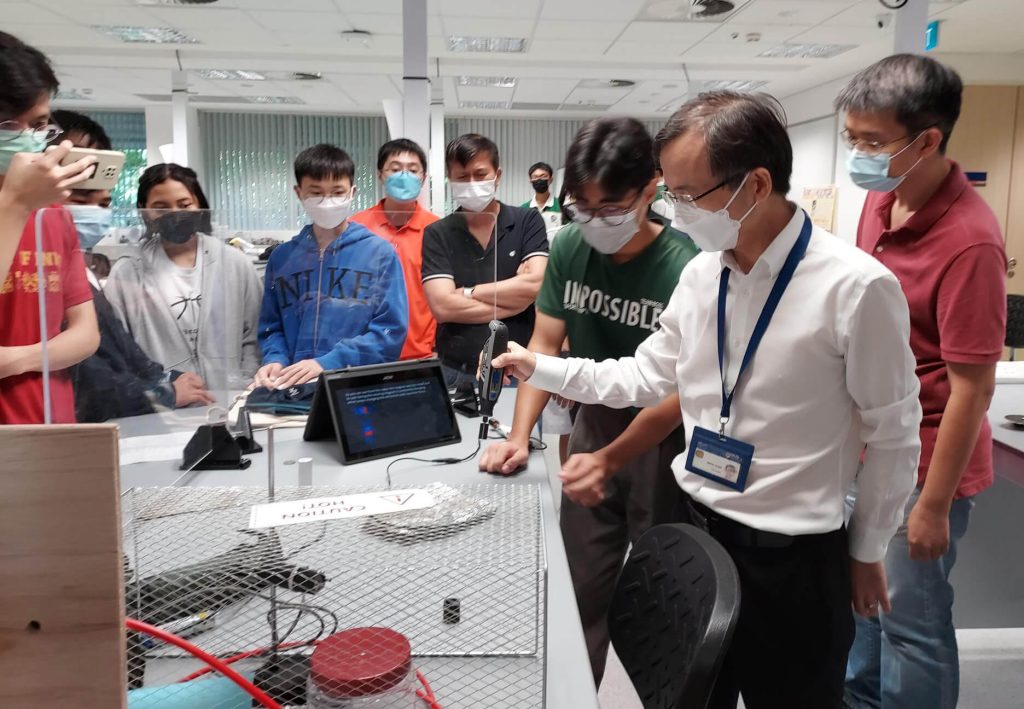Illustratum 2022
A fascination with superconductors prompted Ezell Low to conduct his own research online on floating magnets. Stumbling upon a youtube video on the same topic, the Bedok Green Secondary School student tried experimenting with a Dremel rotary tool that got a magnet spinning along in a holder he designed using CAD and fabricated with a 3D printer.
“The problem I had was the face of the magnet kept moving, and it was hard to find equilibrium with the attractive and repulsive forces kept changing. I tested many times and I wanted to give up, it was hard. But I finally managed to get the magnet floating,” remarked Ezell unassumingly.

Such was the enthusiasm demonstrated by participants of Illustratum 2022, a physics hallway competition for secondary school students. Be it a simple exhibit, live experiment or Tik Tok video, secondary school students were invited to illustrate and explain any physics discoveries of their choice using their own imagination. Illustratum hopes to tap on the creativity of young minds to communicate the concepts of physics that are accurate and captivating. Organised first time by Physics @ NUS with support from Science Centre Singapore and the Ministry of Education, Illustratum 2022 attracted the participation of 54 teams comprising 150 students.
Prior to the actual showcase days, workshops and clinics were organised where participants could meet and interact with the faculty at NUS Physics to clarify any doubts they had or obstacles they were facing. The judging rubrics included accuracy, clarity, level of engagement, ownership where students would be required to keep a journal of their journey and bonus including design, craftsmanship, originality and workmanship.
Prof Lim Tit Meng, CEO of Science Centre Singapore, in his message to students during prize presentation, encouraged students to pursue their passion and interest whether they became physicists in the future or not. The fact that students were driven by curiosity and trying to experiment with things and being passionate about communicating the science behind was a good starting point. He cited the example of American environmental artist and sculptor Ned Kahn who designed artistic physics-based interactive demonstration sets during his undergraduate days and went on to pursue the fusion of art and science with world-renowned exhibits.
“The whole point of this competition is really to help people make sense of what physics is and to make it come alive for our friends around us. Congratulations to all students in this inaugural competition,” remarked Mdm Lee Lin Yee, Director, Sciences Branch, Curriculum Planning and Development Division 1 (CPDD1), Ministry of Education, who delivered a congratulatory message on behalf of the Guest-of-Honour Mr Sin Kim Ho, Divisional Director, CPDD1. The experience student gained from the competition would provide them with the tools such as the ability to use digital and media means to communicate science and STEM to more people. The competition was very open to new ideas or free spirited in terms of not restricting students as to what concepts to share and the manner of presenting them.
“The process of learning and doing science really shouldn’t be just about solving pen and paper questions but building and sustaining a community that promotes a rich and safe space for collaboration, inquiry and exploration.” Mdm Lee ended on a note where she thanked all participants for engaging so actively in the process and hoped this would be a meaningful endeavour for many years to come.
Subscribe to the NUS Physics Telegram @ https://t.me/NUSPHYS
